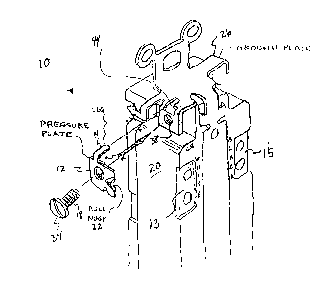Some of the information on this Web page has been provided by external sources. The Government of Canada is not responsible for the accuracy, reliability or currency of the information supplied by external sources. Users wishing to rely upon this information should consult directly with the source of the information. Content provided by external sources is not subject to official languages, privacy and accessibility requirements.
Any discrepancies in the text and image of the Claims and Abstract are due to differing posting times. Text of the Claims and Abstract are posted:
| (12) Patent: | (11) CA 2210359 |
|---|---|
| (54) English Title: | WIRING DEVICE WITH GROUND CLAMPING PLATE |
| (54) French Title: | DISPOSITIF DE CABLAGE A PINCE DE MISE A LA TERRE |
| Status: | Expired and beyond the Period of Reversal |
| (51) International Patent Classification (IPC): |
|
|---|---|
| (72) Inventors : |
|
| (73) Owners : |
|
| (71) Applicants : |
|
| (74) Agent: | KIRBY EADES GALE BAKER |
| (74) Associate agent: | |
| (45) Issued: | 2000-09-05 |
| (22) Filed Date: | 1997-07-15 |
| (41) Open to Public Inspection: | 1998-04-09 |
| Examination requested: | 1997-07-15 |
| Availability of licence: | N/A |
| Dedicated to the Public: | N/A |
| (25) Language of filing: | English |
| Patent Cooperation Treaty (PCT): | No |
|---|
| (30) Application Priority Data: | ||||||
|---|---|---|---|---|---|---|
|
The present invention relates to electrical wiring devices such as
electrical receptacles, switches, and the like, and more particularly to wiring
devices with a clamp for the ground connections to such devices. The present
invention includes a pressure plate which engages the ground plate of a
receptacle with legs of a pressure plate disposed within correspondingly
shaped recesses adjacent the ground plate of the receptacle, so that the
pressure plate is substantially constrained from rotation relative to the groundplate so that a wire can be received between the ground plate and the pressure
plate when the screw is backed out a sufficient distance.
Cette invention concerne des dispositifs de câblage électrique tels que prises, commutateurs et appareils analogues et, plus particulièrement, des dispositifs comportant une pince de mise à la terre. La présente invention comporte une plaque de serage qui s'appuie sur le plot de mise à la terre de la prise. Cette plaque comporte des pattes qui s'engagent dans des évidements ménagés à proximité du plot susmentionné et l'empêchent quasi totalement de tourner par rapport audit plot. Ce montage permet d'insérer un conducteur de mise à la terre entre ladite plaque et ledit plot dès que la vis de pression est suffisamment dévissée.
Note: Claims are shown in the official language in which they were submitted.
Note: Descriptions are shown in the official language in which they were submitted.

2024-08-01:As part of the Next Generation Patents (NGP) transition, the Canadian Patents Database (CPD) now contains a more detailed Event History, which replicates the Event Log of our new back-office solution.
Please note that "Inactive:" events refers to events no longer in use in our new back-office solution.
For a clearer understanding of the status of the application/patent presented on this page, the site Disclaimer , as well as the definitions for Patent , Event History , Maintenance Fee and Payment History should be consulted.
| Description | Date |
|---|---|
| Inactive: IPC from MCD | 2006-03-12 |
| Time Limit for Reversal Expired | 2003-07-15 |
| Letter Sent | 2002-07-15 |
| Grant by Issuance | 2000-09-05 |
| Inactive: Cover page published | 2000-09-04 |
| Inactive: Final fee received | 2000-05-03 |
| Pre-grant | 2000-05-03 |
| Notice of Allowance is Issued | 2000-01-13 |
| Letter Sent | 2000-01-13 |
| Notice of Allowance is Issued | 2000-01-13 |
| Inactive: Approved for allowance (AFA) | 1999-12-14 |
| Application Published (Open to Public Inspection) | 1998-04-09 |
| Inactive: IPC assigned | 1997-10-09 |
| Classification Modified | 1997-10-09 |
| Inactive: First IPC assigned | 1997-10-09 |
| Inactive: Filing certificate - RFE (English) | 1997-09-23 |
| Filing Requirements Determined Compliant | 1997-09-23 |
| Letter Sent | 1997-09-23 |
| Application Received - Regular National | 1997-09-22 |
| Request for Examination Requirements Determined Compliant | 1997-07-15 |
| All Requirements for Examination Determined Compliant | 1997-07-15 |
There is no abandonment history.
The last payment was received on 2000-06-19
Note : If the full payment has not been received on or before the date indicated, a further fee may be required which may be one of the following
Patent fees are adjusted on the 1st of January every year. The amounts above are the current amounts if received by December 31 of the current year.
Please refer to the CIPO
Patent Fees
web page to see all current fee amounts.
| Fee Type | Anniversary Year | Due Date | Paid Date |
|---|---|---|---|
| Application fee - standard | 1997-07-15 | ||
| Request for examination - standard | 1997-07-15 | ||
| Registration of a document | 1997-07-15 | ||
| MF (application, 2nd anniv.) - standard | 02 | 1999-07-15 | 1999-06-16 |
| Final fee - standard | 2000-05-03 | ||
| MF (application, 3rd anniv.) - standard | 03 | 2000-07-17 | 2000-06-19 |
| MF (patent, 4th anniv.) - standard | 2001-07-16 | 2001-06-15 |
Note: Records showing the ownership history in alphabetical order.
| Current Owners on Record |
|---|
| PASS & SEYMOUR, INC. |
| Past Owners on Record |
|---|
| JAMES A. OSTERBROCK |
| MICHAEL R. BRYNDZIA |